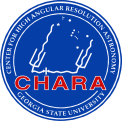The beam samplers are movable stages in the lab that direct the star light from the delay line area to the optical tables in the beam combination area. The light from each telescope can be sent to any of the beam combiners using set positions defined for the beam samplers. These six positions are known as "Beam 1" through "Beam 6".
Each beam combiner uses a fixed set of beams. The light from any telescope can be moved in and out of those beams. Below you'll find recommendations for how to order the telescopes on each beam.
CLASSIC
CLASSIC works on Beams 5&6. With only two telescopes, the choice of which telescope to assign to Beam 5 and Beam 6 is arbitrary.
CLIMB
There are two sets of optical inputs for CLIMB. CLIMB1 operates on Beams 1, 2, and 3. CLIMB2 operates on Beams 4, 5, and 6. Both setups use the same detector. The choice between using CLIMB1 and CLIMB2 will be determined by the lab manager and depends on which other beam combiners are in use. The reference cart is usually selected to be the middle beam (Beam2 on CLIMB1, Beam4 on CLIMB2). For ease of fringe tracking, it is recommended to put the longest baseline on Beams 1&3 for CLIMB1 and Beams 4&6 for CLIMB2.
JouFlu
JouFlu can operate on either Beams 3&4 or Beams 5&6. The choice between the beam setups will be determined by the lab manager and depends on which other beam combiners are in use.
MIRCX
MIRCX uses all six beams (Beam 1 through Beam 6). The new standard beam order for MIRCX is E1-W2-W1-S2-S1-E2. This setup was selected to optimize fringe tracking and signal-to-noise by matching the baseline length with the spatial frequency set by the spacing of the optical fibers. (Note that this is different from the old beam order of W1-S2-S1-E1-E2-W2).
PAVO
PAVO is aligned on Beams 1, 2, and 3. The baselines with the best signal-to-noise are between Beams 2 and 3, then between Beams 1 and 2, and finally between Beams 1 and 3. This is a result of the spatial frequencies defined by the separation between the mask holes for each beam. Therefore, for two telescope PAVO observations, it is best to use Beams 2&3. If you will spend time on one baseline and then switch to another baseline, it is best to stay on Beams 2&3 and move the telescopes during the switch. However, if a program calls for rapid changes between baselines (or if 3T PAVO observations are needed), then it is best to set the longest baseline on Beams 2&3, the second longest on Beams 1&2, and the shortest on Beams 1&3. The throughput on the PAVO beam splitter on Beam 2 has the lowest throughput, which could affect where to put each telescope.
VEGA
VEGA is aligned on Beams 1, 2, 3, and 4. Consult with the VEGA team to determine the best beam order for your program.



